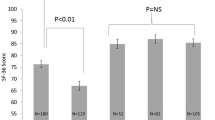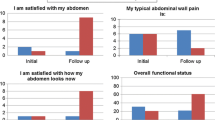Abstract
Background
Ventral hernia repairs are one of the most common surgeries performed. Symptoms are the most common motivation for repair. Unfortunately, outcomes of repair are typically measured in recurrence and infection rather than patient focused results. We correlated factors associated with decreased patient satisfaction, chronic pain, and diminished functional status following laparoscopic ventral hernia repair (LVHR)
Methods
A retrospective study of 201 patients from two affiliated institutions was performed. Patient satisfaction, chronic abdominal pain, pain scores, and Activities Assessment Scale results were obtained in 122 patients. Results were compared with univariate and multivariate analysis.
Results
Thirty-two (25.4 %) patients were dissatisfied with their LVHR while 21 (17.2 %) patients had chronic abdominal pain and 32 (26.2 %) patients had poor functional status following LVHR. Decreased patient satisfaction was associated with perception of poor cosmetic outcome (OR 17.3), eventration (OR 10.2), and chronic pain (OR 1.4). Chronic abdominal pain following LVHR was associated with incisional hernia (OR 9.0), recurrence (OR 4.3), eventration (OR 6.0), mesh type (OR 1.9), or ethnicity (OR 0.10). Decreased functional status with LVHR was associated with mesh type used (OR 3.7), alcohol abuse (OR 3.4), chronic abdominal pain (OR 1.3), and age (OR 1.1).
Conclusions
One-fourth of patients have poor quality outcome following LVHR. These outcomes are affected by perception of cosmesis, eventration, chronic pain, hernia type, recurrence, mesh type, and patient characteristics/co-morbidities. Closing central defects and judicious mesh selection may improve patient satisfaction and function. Focus on patient-centered outcomes is warranted.

Similar content being viewed by others
References
Poulose BK, Shelton J, Phillips S et al (2011) Epidemiology and cost of ventral hernia repair: making the case for hernia research. Hernia 16:179–183
Mudge M, Hughes LE (1985) Incisional hernia: a 10 year prospective study of incidence and attitudes. Br J Surg 72:70–71
Hesselink VJ, Luijendijk RW, de Wilt JH et al (1993) An evaluation of risk factors in incisional hernia recurrence. Surg Gynecol Obstet 176:228–234
Luijendijk RW, Hop WC, van den Tol MP et al (2000) A comparison of suture repair with mesh repair for incisional hernia. N Engl J Med 343:392–398
Burger JW, Luijendijk RW, Hop WC et al (2004) Long-term follow-up of a randomized controlled trial of suture versus mesh repair of incisional hernia. Ann Surg 240:578–585
Fitzgibbons RJ Jr, Giobbie-Hurder A, Gibbs JO et al (2006) Watchful waiting vs repair of inguinal hernia in minimally symptomatic men: a randomized clinical trial. JAMA 295:285–292
Itani KM, Hur K, Kim LT et al (2010) Comparison of laparoscopic and open repair with mesh for the treatment of ventral incisional hernia: a randomized trial. Arch Surg 145:322–328
Kurmann A, Visth E, Candinas D et al (2011) Long-term follow-up of open and laparoscopic repair of large incisional hernias. World J Surg 35:297–301. doi:10.1007/s00268-010-0874-9
Hawn MT, Snyder CW, Graham LA et al (2010) Long-term follow-up of technical outcomes for incisional hernia repair. J Am Coll Surg 210:648–655
Asencio F, Aguiló J, Peiró S et al (2009) Open randomized clinical trial of laparoscopic versus open incisional hernia repair. Surg Endosc 23:1441–1448
Pring CM, Tran V, O’Rourke N et al (2008) Laparoscopic versus open ventral hernia repair: a randomized controlled trial. ANZ J Surg 78:903–906
Olmi S, Scaini A, Cesana GC et al (2007) Laparoscopic versus open incisional hernia repair: an open randomized controlled study. Surg Endosc 21:555–559
Barbaros U, Asoglu O, Seven R et al (2007) The comparison of laparoscopic and open ventral hernia repairs: a prospective randomized study. Hernia 11:51–56
Misra MC, Bansal VK, Kulkarni MP et al (2006) Comparison of laparoscopic and open repair of incisional and primary ventral hernia: results of a prospective randomized study. Surg Endosc 20:1839–1845
Carbajo MA, del Olmo JC, Blanco JI et al (2000) Laparoscopic treatment of ventral abdominal wall hernias: preliminary results in 100 patients. JSLS 4:141–145
Tse GH, Stutchfield BM, Duckworth AD et al (2010) Pseudo-recurrence following laparoscopic ventral and incisional hernia repair. Hernia 14:583–587
Bencini L, Sanchez LJ, Bernini M et al (2009) Predictors of recurrence after laparoscopic ventral hernia repair. Surg Laparosc Endosc Percutan Tech 19:128–132
Franklin ME Jr, Gonzalez JJ Jr, Glass JL et al (2004) Laparoscopic ventral and incisional hernia repair: an 11-year experience. Hernia 8:23–27
Heniford BT, Park A, Ramshaw BJ et al (2003) Laparoscopic repair of ventral hernias: nine years’ experience with 850 consecutive hernias. Ann Surg 238:391–399
Carbajo MA, del Olmo JC, Blanco JI et al (2003) Laparoscopic approach to incisional hernia. Surg Endosc 17:118–122
Rosen M, Brody F, Ponsky J et al (2003) Recurrence after laparoscopic ventral hernia repair. Surg Endosc 17:123–128
LeBlanc KA, Whitaker JM, Bellanger DE et al (2003) Laparoscopic incisional and ventral hernioplasty: lessons learned from 200 patients. Hernia 7:118–124
Gronnier C, Wattier JM, Favre H et al (2012) Risk factors for chronic pain after open ventral hernia repair by underlay mesh placement. World J Surg 36:1548–1554. doi:10.1007/s00268-012-1523-2
Ladurner R, Chiapponi C, Linhuber Q et al (2011) Long-term outcome and quality of life after open incisional hernia repair—light versus heavy weight meshes. BMC Surg 11:25
Snyder CW, Graham LA, Vick CC et al (2011) Patient satisfaction, chronic pain, and quality of life after elective incisional hernia repair: effects of recurrence and repair technique. Hernia 15:123–129
Wassenaar E, Schoenmaeckers E, Raymakers J et al (2010) Mesh-fixation method and pain and quality of life after laparoscopic ventral or incisional hernia repair: a randomized trial of three fixation techniques. Surg Endosc 24:1296–1302
Poelman M, Schellekens JF, Langenhorst BLAM et al (2010) Health-related quality of life in patients treated for incisional hernia with onlay technique. Hernia 14:237–242
Eriksen JR, Poornoroozy P, Jorgensen LN et al (2009) Pain, quality of life, and recovery after laparoscopic ventral hernia repair. Hernia 13:13–21
Uranues S, Salehi B, Bergamaschi R (2008) Adverse events, quality of life, and recurrence rates after laparoscopic adhesiolysis and recurrent incisional hernia mesh repair in patients with previous failed repairs. J Am Coll Surg 207:663–669
Hope WW, Lincourt AE, Newcomb WL et al (2007) Comparing quality-of-life outcomes in symptomatic patients undergoing laparoscopic or open ventral hernia repair. J Laparoendosc Adv Surg Tech 18:567–571
McCarthy M Jr, Jonasson O, Chang CH et al (2005) Assessment of patient functional status after surgery. J Am Coll Surg 201:171–178
http://www.cdc.gov/nhsn/PDFs/pscManual/9pscSSIcurrent.pdf. Accessed 18 Nov 2011
Agresti A (2002) Categorical data analysis, 2nd edn. John Wiley, Hoboken
Kutner MH, Natchtsheim CJ, Neter J et al (2005) Applied linear statistical models, 5th edn. McGraw-Hill Irwin, New York
R Development Core Team (2012) R: a language and environment for statistical computing. R Foundation for Statistical Computing, Vienna, Austria. ISBN 3-900051-07-0. http://www.R-project.org/
Sajid MS, Leaver C, Baig MK et al (2012) Systematic review and meta-analysis of the use of lightweight versus heavyweight mesh in open inguinal hernia repair. Br J Surg 99:29–37
Albright EL, Davenport DL, Roth JS (2012) Preoperative functional health status impacts outcomes after ventral hernia repair. Am Surg 78:230–234
Author information
Authors and Affiliations
Corresponding author
Rights and permissions
About this article
Cite this article
Liang, M.K., Clapp, M., Li, L.T. et al. Patient Satisfaction, Chronic Pain, and Functional Status following Laparoscopic Ventral Hernia Repair. World J Surg 37, 530–537 (2013). https://doi.org/10.1007/s00268-012-1873-9
Published:
Issue Date:
DOI: https://doi.org/10.1007/s00268-012-1873-9




